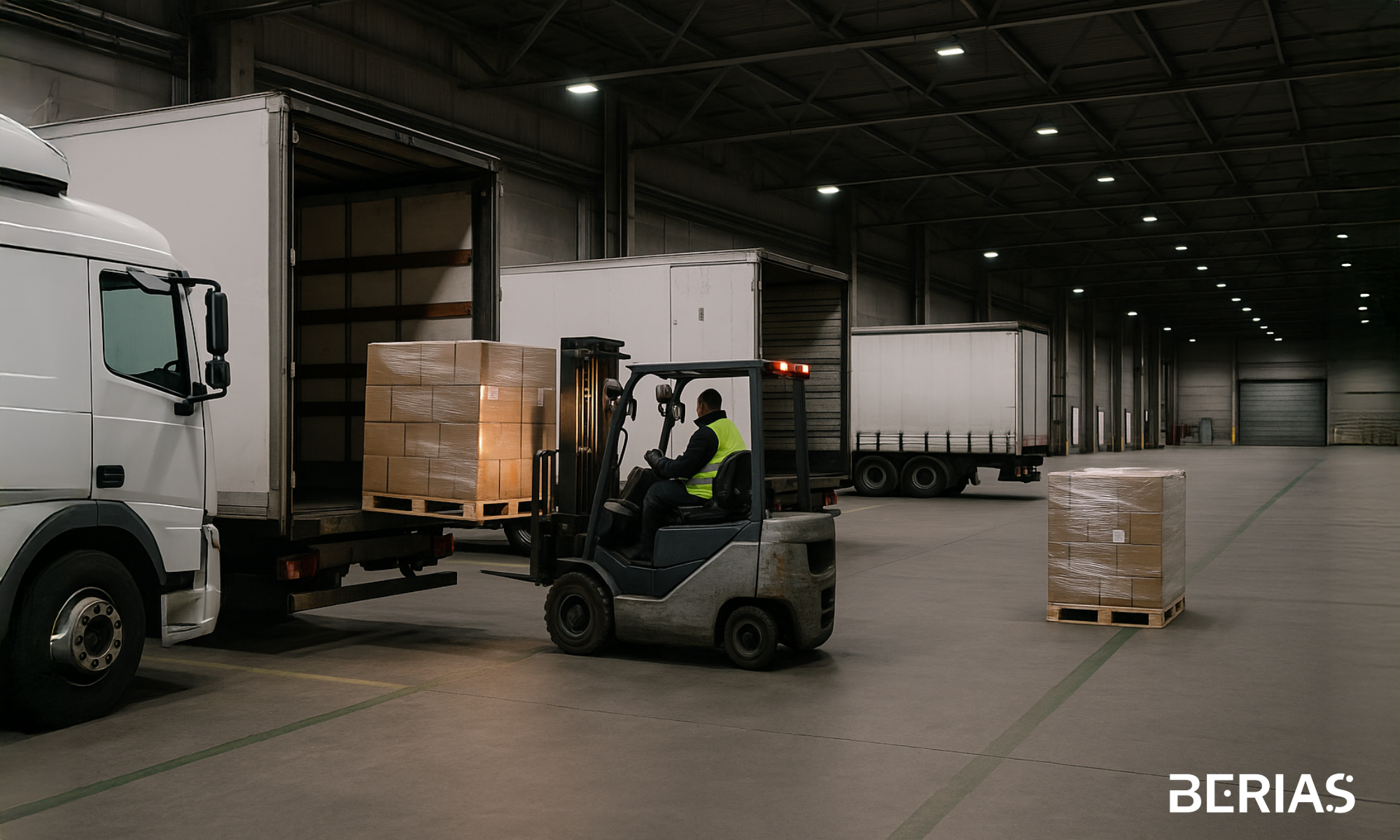The Hidden $500K Problem: How Manual Data Entry Is Draining Your Logistics Company (And What to Do About It)
It’s 3 PM on a Tuesday. Your warehouse manager is still typing data from a scanned bill of lading into a spreadsheet. A process he’s done a hundred times this week. Meanwhile, your dispatch team sits idle waiting for those numbers before they can plan tomorrow’s routes. A driver is stuck in traffic because his schedule was penciled in by hand, missing a more efficient route optimization algorithm could have caught. Your compliance officer is sifting through digital folders looking for a misplaced FMCSA inspection document.
Sound familiar?
If you run a small independent logistics company, with trucking, warehousing, 3PL, or freight forwarding, you already know that manual processes are crushing your bottom line. But here’s what most logistics owners don’t realize: that manual work is costing you closer to $500,000 annually than you think.
And worse, your competitors who’ve automated are already pulling ahead. [Cargowise]
The Real Cost of Manual Data Entry in Logistics
Let’s be honest: logistics is a data-intensive business. You manage invoices, bills of lading, air waybills, driver hours, inventory levels, carrier performance metrics, and compliance documentation. All of it requires accurate, timely data entry. All of it is happening manually in most small logistics operations.
Here’s what the research shows:
Manual data entry errors compound fast. In logistics, inaccurate data entry is one of the most expensive mistakes a business can make. A single misplaced shipment, a route duplication, or an inventory discrepancy triggers rework, expedited shipments, and potential compliance penalties. According to logistics industry research, these errors result in 15-20% of logistics companies’ operational costs going toward corrective actions. [Arrivy] [Cargowise]
Manual processes don’t scale. As your business grows from handling 50 shipments daily to 200, your team doesn’t grow proportionally, but the manual work explodes. You hire more data entry staff, stretch existing employees, and operational efficiency nosedives. [Cargowise]
Compliance burden is suffocating. FMCSA inspection tracking, hours-of-service documentation, and vehicle maintenance logs are increasingly regulated. Manual monitoring means a dedicated team member checking federal portals, updating spreadsheets, and tracking compliance manually, often missing critical updates. The cost? A single FMCSA violation fine averages $4,787 to $7,322 per violation, plus the operational disruption. [Connex]
For a small logistics company with 15 employees processing 150-300 shipments weekly, manual operations translate into:
- 8-10 hours per week on data entry and document processing
- 2-4 hours weekly spent on inventory reconciliation errors
- 3-5 hours weekly on manual route planning adjustments
- 5+ hours weekly on compliance tracking
That’s 18-24 hours weekly of lost productivity, or roughly $18,000-$24,000 annually in direct labor costs alone, before accounting for errors and missed optimization opportunities. [Aptean]
But the real hidden cost? The 15-30% in transportation costs that could be eliminated through route optimization, fuel efficiency, and on-time delivery performance improvements that automation enables. [Log-Hub] [Aptean]
Why Small Logistics Companies Stay Stuck in Manual Mode
The irony is obvious: you know manual processes are inefficient. So why do most small logistics companies still rely on them?
The upgrade myth: Migrating from legacy systems to modern transportation management systems (TMS) or warehouse management systems (WMS) is expensive and time-consuming. Industry benchmarks suggest complex supply chain modernization can take 4-6 years and cost $60,000-$120,000. [Impressit]
System fragmentation: Your dispatch software doesn’t talk to your accounting system. Your inventory tracking is separate from your carrier management platform. Your compliance data lives in an isolated folder. The result: data silos that force manual workarounds and create bottlenecks at every handoff. [Impressit]
Compliance overwhelm: With FMCSA regulations, hours-of-service tracking, and state-specific requirements, compliance feels like a moving target. Many small logistics operators assume that staying compliant requires expensive enterprise-grade software. It doesn’t. [Connex]
“It’s always worked this way”: Legacy thinking. Your company has operated with spreadsheets and manual processes for years. Change feels risky, especially when you’re focused on day-to-day operations.
The Three Operational Bottlenecks Destroying Your Margins
- Manual Fleet Scheduling (The Driver Retention Crisis)
Your dispatcher receives orders in real-time but allocates routes manually. Drivers often stranding far from home or creating inefficient multi-stop sequences. Result: drivers feel undervalued, churn increases, and recruiting costs spike (average new driver hiring cost: $8,200). [Aptean]
Meanwhile, route optimization algorithms could reduce driver hours by 10-30%, improve on-time delivery, and keep drivers happier. A modest 10% reduction in driver hours saves a 15-person logistics operation over $350,000 annually. [Aptean]
- Inventory Management Delays (The Warehouse Penalty)
Without real-time visibility into warehouse inventory, stock discrepancies create a vicious cycle: misplaced items waste picker time, overstocking increases holding costs, stockouts trigger expensive expedited replenishment, and customer satisfaction plummets. [Arrivy]
Implementing a basic warehouse management system (WMS) with real-time inventory tracking reduces stockouts by 35% and dramatically cuts the labor hours spent searching for misplaced products. [Arrivy]
- Compliance Documentation Chaos (The Penalty Waiting to Happen)
FMCSA inspection records, maintenance logs, and driver qualification files are scattered across systems or paper. Smaller fleets have just 24% adoption of automated dash-cam compliance tools, compared to 56% for larger competitors. The compliance gap is real, and it’s costing small logistics companies fines, operational disruptions, and reputational damage. [Foodlogistics]
Manual FMCSA tracking takes 15+ hours per week for a small operation. Automation via the FMCSA public API can save that entire 15 hours and prevent compliance violations before they happen. [Connex]
The Decisive 20%: What Actually Moves the Needle
Here’s where most logistics companies get stuck: they think they need to overhaul everything at once. Full WMS integration, complete TMS deployment, enterprise-level compliance platforms. Budget explodes. Timeline stretches. ROI gets pushed to year three.
But what if you didn’t need to?
The Pareto Principle applies powerfully here: 80% of your operational delays come from just 20% of your processes. [Berias]
For most small logistics companies, that decisive 20% is:
- Automating bill-of-lading and invoice data entry (via API integration with your existing tools)
- Integrating your TMS with your WMS (so dispatch and warehouse teams see the same inventory data in real-time)
- Automating FMCSA compliance tracking (via API calls to federal databases, not manual portal checks)
- Optimizing driver scheduling (via dispatch software API integration with route planning algorithms)
- Creating automated dispatch-to-accounting workflows (so invoicing happens automatically, not manually)
These targeted automations don’t require a six-figure system overhaul. They require strategic process analysis, smart tool selection, and precise API integration between systems you likely already have. [Dispatchtrack] [Cleverroad] [Cadretech]
The math? A logistics company implementing these five targeted automations typically sees:
- 5-10 hours weekly savings in manual data entry
- $15,000-$25,000 annual cost reduction in labor and error correction
- 10-15% improvement in on-time delivery performance
- 5-15% reduction in fuel costs through optimized routing
- Zero to minimal compliance violations through automated monitoring
That’s $30,000-$50,000 in total annual impact. Based on focused, modular process improvements, not a complete system replacement.
Real-World Examples: What’s Working for Small Logistics Companies
Case Study #1: Regional 3PL Operation (12 Employees, East Coast)
The Challenge: Manual route allocation was causing a 2.7-day delay between call-off and pickup, stranding drivers, and frustrating customers. Inventory mismatches happened weekly because dispatch and warehouse teams used separate systems.
The Solution: Integrated TMS with WMS via API; automated dispatch-to-driver notifications; set up real-time inventory visibility dashboard.
The Result: Reduced call-off-to-pickup time by 2.7 days, improved on-time delivery from 78% to 94%, eliminated inventory reconciliation errors. Cost savings: ~$35,000 annually. [Wynnesystems]
Case Study #2: Freight Forwarding Firm (8 Employees)
The Challenge: Manual FMCSA tracking consumed 20+ hours per week. A missed inspection led to a compliance violation and $5,300 fine.
The Solution: Automated FMCSA inspection monitoring via API integration; created Zapier workflow to flag violations within 24 hours; integrated with task management system.
The Result: Eliminated manual tracking, prevented compliance violations, freed up 20 hours weekly. Cost savings: $18,000-$22,000 annually (labor + penalty avoidance). [Connex]
Case Study #3: Small Trucking Company (5 Trucks, Independent Owner)
The Challenge: Driver scheduling was manual; inefficient routes were costing 15% more in fuel than optimal. Data entry errors delayed invoicing by 3-5 days.
The Solution: Implemented route optimization software; connected to TMS; automated invoice generation via API.
The Result: Reduced fuel costs by 12%, improved driver satisfaction (fairer route allocation), accelerated cash flow (invoices sent within 24 hours). Cost savings: $28,000 annually. [Aptean]
Where Most Logistics Companies Go Wrong
Mistake #1: Trying to solve everything at once.
Deploying a full enterprise TMS without understanding your actual pain points is like buying a truck when you need better route planning. Start with the decisive 20%. Check the processes that, if optimized, unlock the most value.
Mistake #2: Assuming integration is impossible.
“Our old system doesn’t talk to modern software.” Actually, APIs and middleware solutions make integration faster and cheaper than ever. Most modern logistics software platforms offer robust API documentation specifically designed for small companies. [Cleverroad]
Mistake #3: Delaying because of perceived complexity.
The ideal time to implement process automation was five years ago. The second-best time is right now. Small, focused improvements compound quickly. You don’t need a massive project; you need strategic execution.
Mistake #4: Not measuring the real ROI.
Many logistics companies improve their processes but don’t quantify the impact. Track these metrics before and after:
- Hours spent on manual data entry (weekly)
- Inventory accuracy percentage
- On-time delivery rate
- Fuel cost per mile
- Driver turnover rate
- FMCSA compliance violations
- Days to invoice
The Speed Advantage: Why Micro-Consulting Works for Logistics
Here’s the reality: you don’t need a six-month consulting engagement or a team of MBA consultants to solve your logistics challenges. You need an expert who understands logistics operations, can quickly identify your decisive 20%, and help you implement targeted automation.
That’s where Adaptive Micro-Consulting comes in.
Unlike traditional consulting firms that require month-long engagements and bloated fees, Adaptive Micro-Consulting delivers focused, rapid process analysis and actionable automation strategies in focused 1-2 hour sessions.
How it works:
- Rapid Operations Audit: Your logistics operations are analyzed against proven best practices. Bottlenecks and high-impact opportunities are identified using the Pareto principle, finding the 20% that drives 80% of results.
- Targeted Integration Plan (60 minutes session): A clear, step-by-step roadmap for automating your decisive processes. No fluff. Specific tool recommendations, integration points, and implementation timeline.
- Immediate Action Plan: You leave the session with a prioritized, executable plan, not theoretical recommendations gathering dust on a shelf.
For small logistics companies, this approach means:
- Speed: Problems identified and solutions planned in days, not months
- Cost: $249 per session, no hidden fees or multi-month commitments
- Relevance: Recommendations grounded in your specific operations, not generic consulting playbooks
- Execution: Clear next steps you can implement immediately with your existing team or with targeted development support
Your Next Move: Start Here
Week 1: Assess Your Situation
Document your current manual processes. Which tasks consume the most time? Where do errors occur most frequently? Where are your compliance risks?
Week 2: Identify Your Decisive 20%
Of all your manual processes, which three would unlock the most operational and financial value if automated? That’s your starting point.
Week 3: Get Expert Input
Book an Adaptive Micro Consulting session with an automation specialist. Bring your top three challenges. Leave with a concrete automation roadmap.
Week 4+: Execute
Implement your top priority automation, measure the results, and move to the next.
The logistics companies winning right now aren’t the ones waiting for a perfect moment to overhaul everything. They’re the ones making small, focused improvements, month after month, quarter after quarter. They’re automating the decisive 20% and leaving their manual-reliant competitors behind.
Ready to stop losing $500K to inefficiency? Book your Adaptive Micro Consulting session today and discover the specific automations that will move your logistics business forward.
Schedule Your Logistics Automation Strategy Session
25. November 2025





